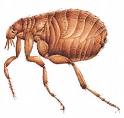Flea
Siphonaptera
 |
|
Cat fleas (Ctenocephalides felis) are frequently encountered in homes and are common pests on domestic cats and dogs. Dog fleas (Ctenocephalides canis) look like cat fleas, but are rare in California. Sticktight fleas (Echidnophaga gallinacea) can become a problem when pets frequent areas near poultry. Female sticktight fleas firmly attach themselves around the ears and eyes of their host. Fleas on either cats or dogs in California are most likely cat fleas.
Habits
Fleas transport themselves on rodents and other mammals. They infest both household pests and wild animals. Fleas use their powerful legs to jump as high as 8 inches vertically and 16 inches horizontally.
Habitat
Fleas usually remain on their warm-blooded hosts at all times. They can also be found on shoes, pant legs, or blankets, which can transfer the fleas to new environments. They are often found infesting opossums, raccoons, and skunks in urban settings.
Threats
The cat flea is suspected of transmitting murine typhus to humans, but its primary importance is in its annoyance to people and pets. Cat fleas readily try to feed on almost any warm-blooded animal. Some people are bothered by the sensation of fleas walking on their skin, but bites are the major nuisance. Bites tend to be concentrated on the lower legs but can also occur on other parts of the body. The bite consists of a small, central red spot surrounded by a red halo, usually without excessive swelling. Flea bites usually cause minor itching but may become increasingly irritating to people with sensitive or reactive skin. Some people and pets suffer from flea bite allergic dermatitis, characterized by intense itching, hair loss, reddening of the skin, and secondary infection. Just one bite may initiate an allergic reaction, and itching may persist up to 5 days after the bite. Cat fleas may also serve as intermediary hosts of dog tapeworms. Cats or dogs may acquire this intestinal parasite while grooming themselves by ingesting adult fleas that contain a cyst of the tapeworm.
Prevention:
The best approach to managing fleas is prevention. New, safer, and more effective products aimed at controlling fleas on the pet have made flea management without pesticide sprays feasible in many situations. Management of fleas on the pet must be accompanied by regular, thorough cleaning of pet resting areas indoors and outside. Once fleas infest a home, control will require a vigilant program that includes cleaning and treating infested areas indoors, eliminating fleas on pets, and cleaning up and possibly treating shaded outdoor locations where pets rest.


